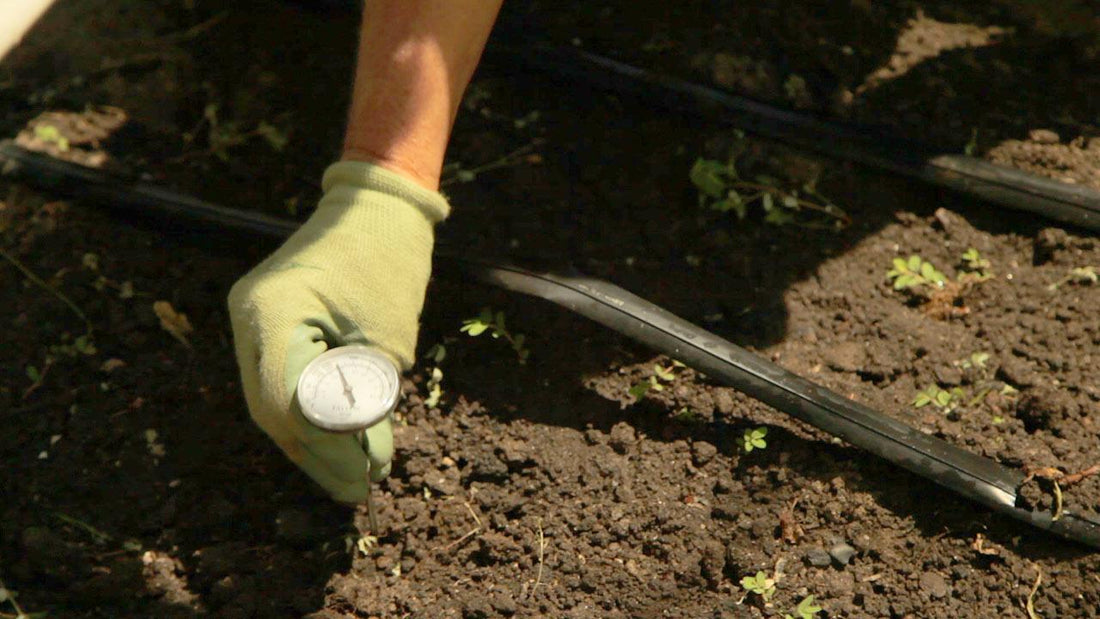How to Check and Control Soil Temperature for Healthy Vegetable Transplants
Soil temperature plays a crucial role in vegetable gardening, determining how well seedlings establish themselves and how successfully plants grow. While air temperature is often a focus for gardeners, soil temperature is just as important—if not more so—when it comes to germination, root development, and overall plant health. Checking your soil temperature before transplanting vegetable seedlings can prevent common problems like slow growth, weak roots, or transplant shock.
In this guide, we’ll discuss how to check soil temperatures, the ideal soil temperature ranges for different vegetables, and methods to raise or lower soil temperatures to give your plants the best start.
Why Soil Temperature Matters for Vegetables
• Proper root development – The right soil temperature ensures that roots grow quickly and take in nutrients efficiently.
• Successful transplanting – If the soil is too cold or too hot, transplants may struggle to establish themselves, leading to stunted growth or even plant loss.
• Stronger plant immunity – Vegetables growing in ideal soil temperatures are more resistant to diseases and pests, giving them a healthier start.
• Higher yields – When soil temperatures are optimal, plants can maximize their growth potential, leading to bigger harvests and stronger plants.
How to Check Soil Temperatures
Checking soil temperature is simple with the right tools. Use a soil thermometer to measure the temperature accurately. There are two main types:
• Dial-style soil thermometers – These are analog thermometers with a metal probe that you insert into the soil.
• Digital soil thermometers – These give a more precise reading and often have a faster response time.
Steps to Check Soil Temperature
- Insert the thermometer 2 to 4 inches into the soil, where most seeds or transplants' roots will be placed.
- Leave the thermometer in the soil for about a minute until the reading stabilizes.
- Take readings in the morning and afternoon for a more accurate daily average.
- Check temperatures for several days before transplanting to ensure the soil is warm enough.
- Monitor weather forecasts—a sudden cold snap can lower soil temperatures, potentially harming newly transplanted seedlings.
Optimal Soil Temperatures for Transplanting Vegetable Seedlings
Different vegetables require specific soil temperatures to thrive. While many crops can tolerate slightly cooler or warmer conditions, planting them within their ideal range will help ensure strong root development and vigorous growth.
General Soil Temperature Guidelines for Common Vegetables
• 60–65°F – Ideal for cabbages, beans, lettuce, and peas.
• Below 75°F – Best for corn, as excessive heat can dry out soil too quickly.
• 75°F – Preferred for peppers, tomatoes, eggplants, and squash.
Vegetable Soil Temperature Chart
| Vegetable | Minimum Temperature | Ideal Transplant Temperature |
|---|---|---|
| Lettuce | 35°F | 60–65°F |
| Peas | 40°F | 60–65°F |
| Beans | 55°F | 60–65°F |
| Tomatoes | 55°F | 70–75°F |
| Peppers | 65°F | 75°F |
| Corn | 50°F | Below 75°F |
| Squash | 65°F | 70–75°F |
If soil temperatures are too low when you transplant seedlings, root growth may slow down, increasing susceptibility to pests and diseases. Conversely, soil that’s too hot can stress young plants and dry out the soil too quickly.
How to Raise Soil Temperature
If the soil is too cold, you can take a few simple steps to warm it up before planting:
• Use black or thermal mulch – Spreading a layer of black plastic mulch or Thermal Green Mulching Film on the soil absorbs heat from the sun, warming the soil underneath. Remove it at planting time or cut holes for seedlings.
• Cover soil with row covers – Floating row covers trap heat and insulate seedlings, keeping the soil warm at night.
• Water with warm water – Using slightly warmer irrigation water (not hot) can gradually increase soil temperature.
• Raised beds warm up faster – If you’re dealing with cold, heavy soil, planting in raised beds can help soil warm up quicker in spring.
• Compost and organic matter – Adding decomposing organic matter increases microbial activity, which naturally warms the soil.
How to Lower Soil Temperature
If your soil is too hot, certain strategies can help cool it down to keep plants healthy:
• Apply a thick layer of mulch – Organic mulches like straw, wood chips, or compost help retain moisture and lower soil temperature.
• Shade cloth or row covers – Providing temporary shade during the hottest part of the day can reduce soil heat buildup.
• Increase watering frequency – Moist soil stays cooler than dry soil, so keep it well-watered, especially during hot weather.
• Plant cover crops – Ground cover plants like clover or low-growing greens keep the soil shaded, reducing heat absorption.
Final Tips for Successful Transplanting
• Transplant in the early morning or evening when temperatures are cooler.
• Acclimate seedlings by hardening them off before planting them outdoors.
• Space plants properly to avoid overcrowding, which can increase soil temperature and promote moisture loss.
• Monitor soil temperatures throughout the season—even after transplanting, maintaining the right temperature is crucial for ongoing plant health.
Conclusion
Soil temperature is one of the most overlooked factors in vegetable gardening, yet it plays a critical role in plant success. By monitoring soil temperature before planting, using mulches, row covers, and proper irrigation to regulate warmth, and following transplanting best practices, you’ll give your vegetable seedlings the best possible start.
Whether you're growing cabbage, tomatoes, peppers, or corn, ensuring the right soil temperature will lead to healthier plants, faster growth, and bigger harvests.
So, before you plant, grab a soil thermometer and check your soil! Your vegetables will thank you with a bountiful harvest.



